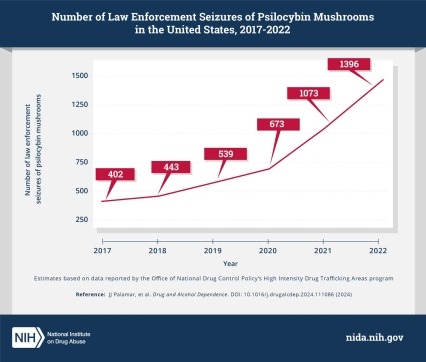

Law enforcement seizures of “magic mushrooms” or “shrooms” containing the psychoactive component psilocybin increased dramatically in the United States between January 2017 and December 2022, according to a new study funded by the National Institute on Drug Abuse, part of the National Institutes of Health. The number of law enforcement seizures increased from 402 seizures in 2017 to 1,396 in 2022. In addition, the total weight of psilocybin mushrooms seized by law enforcement increased from 226 kg (498 lbs) seized in 2017 compared to 844 kg (1,861 lbs) in 2022.
The researchers found that most seizures occurred in the Midwest (36.0%), followed by the West (33.5%). The greatest total weight in seizures came from the West (1,864 kg/4,109 lbs, representing 42.6% of all seizures), followed by the South (1,832 kg/4,039 lbs, representing 41.8%). Though there was a significant increase in the total weight of psilocybin mushrooms seized between 2017 and 2022 overall, the investigators found that the total weight seized peaked in 2021 (1,542 kg/3,400 lbs).
This analysis, published in Drug and Alcohol Dependence, was led by researchers at NYU Langone Health, New York City, and the University of Florida, Gainesville. The data used for the analysis were collected through the High Intensity Drug Trafficking Areas (HIDTA) program, a grant program aimed at reducing drug trafficking and misuse administered by the Office of National Drug Control Policy. Though law enforcement seizures do not necessarily reflect prevalence of use, they represent an indicator of the availability of illicit drugs.


Psilocybin mushrooms fall under a broader drug category known as psychedelic and dissociative drugs, which can temporarily alter a person’s mood, thoughts, and perceptions. Self-reported data on the prevalence of their use is limited, though available research suggests that use of drugs like psilocybin that cause hallucinations has increased among adults aged 35-50 in recent years. In addition, research suggests that psilocybin is the most consumed plant-based psychedelic drug in the United States, with 11.3% of individuals aged 12 or older in the United States reporting having ever used psilocybin in 2022.
“We are in the middle of a rapidly evolving cultural, media, and legal landscape when it comes to psychedelics, and we need data to help shape informed and appropriate public health strategies,” said NIDA Director Nora D. Volkow, M.D. “Moving forward, we must continue to track data on the availability of psychedelics, patterns in use, and associated health effects to guide efforts in promoting accurate education and reducing potential harms among people who do plan to use psychedelic drugs.”
Psilocybin is not currently approved by the U.S. Food and Drug Administration for the treatment of any condition or disease. In recent years, there has been growing research interest in the potential of psychedelic and dissociative drugs to treat medical conditions, including mental health disorders. Importantly, research on psychedelics as a medical treatment is done within a therapeutic structure, which includes a preparatory session with a clinician, a controlled environment and supervision while experiencing the effects of psilocybin, and follow-up sessions.
However, most people who report using psychedelic and dissociative drugs do so outside of medical or research settings for a variety of reasons, including for recreation, or based on the belief that doing so will improve well-being or allow for spiritual or self-exploration. Adverse effects have been associated with use of psilocybin mushrooms, such as “bad trips,” which are marked by distorted thinking, perceptual changes, putting oneself in physical danger, and intense feelings of fear, anxiety, and confusion. People who take psychedelic drugs like psilocybin may also experience short-term side effects such as raised blood pressure and heart rate, agitation, confusion, vomiting, or nausea, which may be severe and require medical attention. In recent years, possession of psilocybin has become increasingly decriminalized throughout the U.S. at the state level. Together, the authors note that these factors may influence nonmedical or recreational use of psilocybin mushrooms in the U.S.
“While psilocybin is by no means the most dangerous drug, recreational use can come with unforeseen risks such as bad trips” said Joseph J. Palamar, Ph.D., M.P.H., associate professor at the NYU Grossman School of Medicine and co-investigator on the NIDA-funded National Drug Early Warning System (NDEWS) and lead author on the paper. “Research studies suggesting its effectiveness in treating mental health issues and extensive positive media coverage may lead some people to seek shrooms outside of medical contexts. People who use psilocybin outside of medical supervision need to be educated about risks associated with use.”
The authors note that states and regions where seizures are reported don’t necessarily reflect the intended destinations for the seized psilocybin mushrooms. In addition, law enforcement efforts may vary across areas, and a higher number of seizures could be a result of increased vigilance by law enforcement. HIDTA seizures don’t encompass all drug seizures in the US; however, the researchers did observe similar overall increases by region based on data published by the DEA National Forensic Laboratory Information System. The authors also note that it is unknown to what extent psilocybin mushrooms were seized in “wet” or “dry” form, which can significantly impact the recorded weight of each seizure and prevents weight measures from being translated into possible doses.
“Most national surveys and studies don’t capture self-reported data on psilocybin use specifically, so these findings help shed important light on an area where we’ve been largely left in the dark,” said Linda B. Cottler, Ph.D., M.P.H, principal investigator of NDEWS, University of Florida, and author on the paper.

